- Aubergines or eggplants as we also call them were thought to be exotic and a real tricky customer. Now they are becoming popular vegetables to grow at home in the greenhouse, mainly thanks to new cultivars that are more suited to the British climate.
Aubergines belong to the same family as tomatoes, potatoes and peppers and they are all members of the Solanaceae family. Unlike aubergines, these other food sources were all found in the Americas whereas the eggplant is Asian in origin. It most likely came from India because of its prominent place in that country’s cuisine.
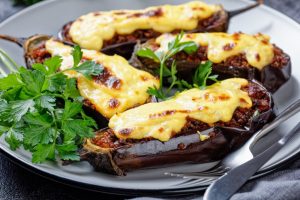
The eggplant is long associated with Mediterranean dishes. Moussaka from Greece is probably THE iconic eggplant dish. In India it is known as brinjal where it makes a tangy chutney too.
Vegetarians and vegans have given new life to this meaty vegetable by using it to create texture and absorb flavour. Chefs have let it shine as a focal point in all sorts of cuisine.
Look out for aubergine ‘facon’ which is the equivalent of bacon and steaks too making use of the vegetable’s texture to be cooked and molded according to taste. Incidentally, we will refer to the usuable part as a fruit from now on.
Commercially in Asia it is a highly productive and important food crop. These plants probably began cultivation in India. The Chinese adopted the plant too. They started growing them 2,500 years before they were taken along the silk road and then grown both in the Middle East and Africa. In Europe, the fruits were cultivated as a result of trading with merchants from the Middle East.
The French know the plant as ‘aubergene‘ because the Spanish call them’ berenjena‘ which is derived from Moorish Arabic. The Italians call aubergines ‘melazana‘ or mad apples which again is derived from Arabic and refers to a particular type of aubergine which they were especially fond of. The name became ‘melongene‘ and led to the scientific name Solanum melongena.
The Versatility Of The Aubergine
Aubergines produce extremely versatile and delicious fruit although these are all used in savoury dishes. When you think of eggplants, what immediately springs to mind are the large oval shaped deep purple even black fruits. Delve more deeply, and what is revealed is a tremendous variety of shapes and sizes. All of them will range from that infamous purple colour to white, other types include pink, orange, yellow and green. Some have shades in between these colours, and then some with stripes, freckles and patches all thrown into the mix. Then are the shapes – round or spherical, long and thin. Frankly, there are too many to try!
Sunshine and warm growing conditions are the keys to success as they grow similarly to tomatoes and peppers. The modern varieties have raised the cultivation potential of the aubergine considerably. Most heritage varieties need a good, long hot summer to really thrive. The more modern varieties which are suited to a UK summer do better and can be grown outdoors. However, the greenhouse or polytunnel really is the best place for them unless you live in a frost free, relatively warm part of the UK.
Modern cultivars are F1 hybrids. There are also a number of wide ranges of older open pollinated types which have been bred in East and South Asia. Some are now offered as highly attractive plants with their profusion of faded felt purple flowers and interesting fruits.
They make great ornamental plants for the warm conservatory and sunny patios in more northern climates. Try them in containers too.
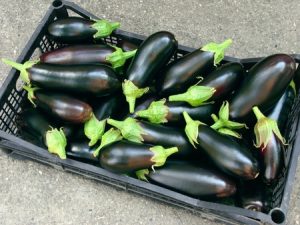
Varieties Of Aubergines
Eggplants are also available as different sized plants to suit any size of garden. Some form small bushy plants which fit a container and are best suited to patios and warm sunny parts of the garden. Others will form large extensive networks which might best be suited for the greenhouse. What is the case that aubergine seeds are best sown as early as possible because they have such a long growing season. We start them off in January under cover of the greenhouse and they rarely disappoint.
‘Black Beauty’. A high-yielding variety with a long growing season. If you get off to an early start, it can be fruiting from summer to the first frosts. Produces strong plants that grow up to 4 ft (1.2m) high, with ornamental starry flowers followed by large glossy globose purple-black fruits. Start sowing this one in February and preferably under the cover of a warm greenhouse or indoors with high humidity levels. We have had a good crop when the plant was grown outdoors in a sunny, sheltered spot.
The vegetarian’s dream aubergine because of its great cooking potential. Pick when fruit is small or large and great for stuffing too. This is one for all those fabulous Mediterranean dishes.
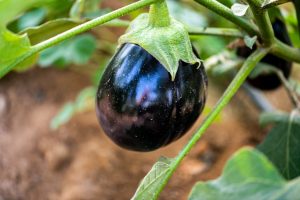
‘Black Pearl‘ F1 hybrid. Deep coloured, high-yielding type, suitable for greenhouse growing.
‘Bonica’ AGM F1 hybrid: Ideal for an unheated glasshouse, early cropping with top-quality, good-sized, attractive, glossy black fruits. More tolerant of a cooler season than some.
‘Clara‘ AGM F1 Hybrid. Heavy cropping with large white fruits. Not suitable for outdoor cultivation.
‘Emerald Isle‘ F1 hybrid. A stunning variety of numerous small green fruits. They look like eggs with their special and unique blotched green skins. we pick the fruits from July onwards and they are super in all sorts of dishes. You could have an overabundance with this variety so worth culinary experimenting. A variety for a container and small spaces on a patio or sunny part of the garden. We grew this variety on the veg. patch in spaces near the broad beans because it had similar height and bushiness. Best to harvest the fruits between 4cm and 10cm long.
‘Fairy Tale‘ AGM. Compact plants bearing many elongated small lavender-purple fruits. Well suited to container cultivation.
‘Galine‘ AGM F1 hybrid. Compact, producing small purple fruits, suitable for containers.
‘Giotto‘ F1 hybrid: Moneymaker type with tolerance of verticillium root disease. Round fruits. Good for outdoor cultivation because of its verticillium resistance.
‘Kaberi‘ AGM F1 hybrid. Compact fruits, suitable for container and patio cultivation.
‘Long Purple‘ & ‘Early Long Purple 2‘ – a very popular variety with a rather unexciting name although it is truly as long as that photo shows. There are similar names for the same variety. Good long, slim fruit up to 25cm in length. Excellent when used in classic Mediterranean dishes and ideal for vegetarian cooks of ‘facon’. Another reason for growing this variety are the wonderful purple flowers that light up a sunny area of the patio or veg. plot. This particular variety needs a long growing season with lots of warmth and sun. we sow seed under warm glass in January and no later than April. Anything afterwards is a disappointment in the UK and apparently other northern hemisphere areas. Produces one of the tallest plants at 8 feet and it needs support. We have grown it against runner bean canes.
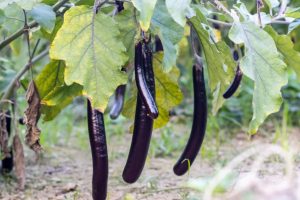
.
‘Ophelia’ – common type and quite hardy. Always reliable and should be more widely grown.
‘Moneymaker‘ F1 hybrid. Large slightly elongated purple-black fruits and a purple calyx. Nowadays being superseded by modern cultivars but is worth it for cooler environments. Good for outdoor growing and crops relatively earlier than most.
‘Pinstripe‘ F1: -An attractive and compact variety for patio tubs and containers. The compact growing habit makes them ideal for restricted spaces in the vegetable patch or on the patio. It needs full sun to really flourish. The leaves are silver green and a prolific producer of attractive small white with purple streaked fruit. These look more like eggs than any other variety and are spineless. In fact the whole plant has great ornamental value as well as creating an abundant crop.
‘Pintung Long’: The slender lavender/purple fruits, which are tender and full of flavour, grow to 30cm long.
‘Rosa di Bianca‘ (Organic) F1 hybrid. An old variety – now heirloom. Attractive, spherical fruits which are pink skinned and mottles with mauve. Has a creamy, delicate consistency and not prone to being bitter.
‘Thai Green Pea’: A tall plant, covered with masses of tiny green fruit with a strong aubergine flavour. Ideal in Thai recipes.
‘Red Egg’ a fat red fruiting type
‘Rossa Bianca’: A gourmet variety with white, rose-tinted fruit and a mild, creamy taste.
‘Violette di Firenze’: Unusual dark mauve fruits make this an attractive plant for the potager. It needs warmth to ripen fully and is similar but a longer version.
‘White Knight‘: Unusual because the fruit is such a translucent white colour. They’re also long and narrow. The plant is compact which makes it ideal alongside ‘Pinstripe’ for the patio and small garden. The fruit has a particularly thin skin which is excellent for barbecuing, roasting and sauteing. Probably one of the most disease-resistant which means that it’s a good one for those new to growing eggplants. Experts grow it purely for its ornamental value too. Buy seed from Marshalls (www.marshallsgarden.com).
Seed Sowing
The longer the growing season the better when it comes to the aubergine – that’s a fact that should always be borne in mind.
The seed must be sown as early in the year as possible; February is the earliest time because of cold outdoors so a heated plant propagator is invaluable. Heat and light are your friends here if you want solid growth.
If you cannot provide the heat and light needed then delay sowing until March or April. May is really the last month if you want to see any plants produce decent sized fruit.
Scatter the seeds thinly on top of moist multi-purpose compost – Levingtons No. 1 is ideal. Most seeds germinate so you only need to sow two more seeds than you need in case of losses from wilt. We sow one or two seeds in either small pots or module (cell) trays.
Place in a propagator. A temperature of 21ºC (70F) is ideal but you can be as low as 18ºC (65F) if necessary.
If you are growing in a heated greenhouse, cover seeds with a fine layer of vermiculite, water and label – this is important to help you identify them when sowing several varieties.
Alternatively, germinate seedlings in the airing cupboard or warm but dark room to begin with. Cover the seeds trays when growing indoors either in the dark or covered with a sheet of opaque polythene or dark brown paper but let air circulate.
Light is important but not necessary in the first instance. Only bring into a warm, light once these very small seedlings have germinated. Growing lights are ideal if you had sown seed in February to March. Any other seeds like chilli and tomato can also be grown under the same light system to maximise energy resources.
Natural light is enough from mid-March onwards.
Check your watering every few days. Water any dry patches using a fine spray mist.
The seedlings germinate within 10 to 14 days. At this stage the propagator lid can be ventilated and eventually removed.
If your seeds germinated early enough, maintain local heat but once the seedlings have established and the first leaf appears, reduce the heat to about 15ºC (60F). Natural day light helps to make the plants sturdy as well as strong.
- If you are unable to really grow these as seeds then we recommend buying in young plants.
Growing On Aubergine Plants
Although aubergines can be grown outside, they rarely do well except in mild areas or during very good summers. As a result they are better grown in a greenhouse or growing frame.
Plant the seedlings, as soon as they can be handled. Grow in 9cm (3½in) pots initially or cells from February onwards. Use a good general purpose compost, ideally peat-free and in a bright, warm place. Although a heated greenhouse (20-27 Centigrade) is great, good results are also possible using sunny windowsills.
Feed plants every week from four weeks after potting, using a balanced liquid fertilizer for a month. Then feed every 14 days with a high-potash tomato fertilizer.
The seedlings need to be watered regularly
If planting out is not possible until later, repot these pots when the roots have fully filled their containers into 12-15cm sizes.
When the next pot is filled with roots, transfer plants again to 23cm (9in) pots of compost in April in a heated greenhouse, or early May if unheated, or the end of May or early June if growing outdoors.
Plants can be put into greenhouse growing bags or larger pots even. A grow bag will hold three plants.
We prefer black pots filled with growing bag compost and placed in a bag. Black pots offer the warm root conditions that aubergines love as they harvest the sun’s warmth. Allow 45cm between plants and 75cm between rows.
Keep between 20 and 27ºC. Do not allow temperatures to fall below 12ºC.
Just to repeat – the best crops are always obtained under glass or a large cloche.
Outdoor Growing
Aubergines can also be grown in the open ground, in warm parts of Britain, spacing 60cm (2ft) apart, and ideally covered with cloches or fleece. Crops will be poor if the summer is wet and cold! Using a cover is only needed though when the summer weather turns wet and cold.
If you didn’t know already, the keys to success with this vegetable are sunshine and warm growing conditions. Warm the soil with polythene or cloches two weeks before planting once there is no danger of frost and cover young plants in cloches or frames for a further two weeks until acclimatised.
Grow them in a sheltered, sunny position, ideally against a warm, sheltered wall. Start this type of growing in early June. A modest crop should be possible.
It is feasible to obtain ready grown young plants as offered by mail-order or through garden centres. They are available from mid-spring at reasonable prices. Such plants need a long growing season so such plants are invaluable when temperatures are too low for sowing and a heated greenhouse is not possible.
Interesting results are obtained with grafted plants where they are grown on tomato rootstock. The rootstock offers exceptional vigour and also resists widespread verticillium fungal wilt disease.
Growing On In the Greenhouse Or Outdoors – The Summer Months
Flowers are self-fertile but a lack of fruit set is a major problem with these plants. It all depends on the growing conditions and if these can be improved then do so.
Generally, the plants are sturdy enough in the beginning to keep upright with their own support. Regular pinching out is rarely needed except for the situation described next.
Plants should be staked and tied against stout canes as they grow because the fruits will be weighty and hopefully numerous. When plants are 25-30cm (10-12in.) high, the tip is removed from the main stem to encourage further spreading and fruiting.
The first flowers appear when the plants are quite small. You should see these flowers in mid-Summer. When this happens feed weekly with a high potash liquid feed such as one used for tomatoes.
Water regularly and feed with a high potassium liquid fertiliser every two weeks once the first fruit has set. Water more regularly as the weather gets warmer. We mulch our plants around the roots growing in pots or when outdoors so as to retain water during those hot summer months.
Mist the foliage regularly when they are grown indoors, at least twice daily with tepid water. They love high humidity, it reduces red spider mite and helps fruit to set.
Once five or six fruits are set, all flowers should be removed. However, cultivars producing small or round fruit can be allowed to produce many more.
Some additional staking may be needed to prevent branches snapping too. Indoor plants benefit from canes and string as tomato plants do but if outdoors we just firmly tie to a stout cane.
Container Growing Of Aubergines
Container growing of aubergines is relatively straightforward and treatment is virtually the same as those grown in grow bags. If you are growing them for the patio, choose a variety with attractive large flowers and colourful shiny fruit.
If the weather turns poor then they can easily be taken up and moved indoors to the greenhouse or polytunnel. Keep them there if the weather remains awful. It also helps to have them there in late season to ripen any fruit.
Just an interesting note – modern varieties are free of spines but it is always surprising to find very sharp spines on the calyx and even growing from the leaves, especially the top.
Harvesting
Most plants produce more than six fruits but this depends on the weather and the variety.
Varieties like Moneymaker F1 and Black Beauty produce such large fruit that its best to restrict the crop to five or six fruits. It’s a good idea to do this level of culling with later sown plants because the fruits do not ripen so well when the plant is cluttered.
Each fruit is cut from August onwards when they’ve grown about 15cm (6in.) long and the skin surface is still shiny. The fruit should also turn slightly soft to the touch. Cropping can continue well into the winter.
As the stems are tough, use a pair of snips or secateurs. Try not to damage the stem because this is easy enough to do with such tightly packed fruit at times.
Harvest fruits as soon as they begin to develop their colour. If the fruits are white, pick when firm and glossy. Harvesting stimulates further fruits to form until the winter weather arrives.
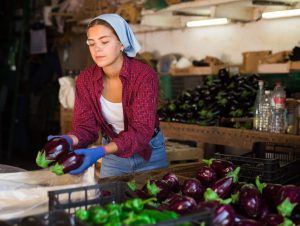
Problems Growing Aubergines
Aubergines are generally pest and disease free but you can encounter issues with greenfly and aphids. Greenfly are a nuisance in the early phases of growth but are not usually an issue once the plants are established. We just rub the greenfly off with the thumb but you can use an organic pesticide. Insecticides based on vegetable oils and fatty acids or soaps work well with aphids and with whitefly to some extent (see below). Use biological controls if necessary and encourage hoverfly where feasible.
Whitefly is an occasional problem. They tend to be more resistant than greenfly to pesticide. We also use sticky yellow traps to remove a few. Again predator control but using Encarsia insects will work effectively.
If the infestation is too large, some preliminary treatment is needed before any biological control can be used effectively. The pretreatment has little impact on the beneficial insects or the later biological controls
Another problem is red spider mite and the one to watch out for but later on in the summer. It prevails when plants are under stress from dry conditions and is the bane of indoor growers.
Raise the humidity using spray misting and try and bring in predators to be truly effective. A biological control is possible using the tiny mite phytoseiulus. Always introduce predators into the greenhouse etc. before red spider mite becomes too numerous.
Another issue caused by poor watering regimes is blossom end rot which is irreversible and leads to fruit loss. Whilst we advocate misting, always soak the plant from the base.
If the leaves and fruits are being eaten and holes are evident, then a number of problematic pests are about. The damage is most likely produced by tomato moth caterpillars, snails, slugs etc. These are best picked off and squashed using a torchlight after dark.
We have mentioned verticillium fungal wilt a few times. It is a common fungus found in soils where it persists for long periods. It invades water conducting vessels called the phloem which passes into leaves or various parts of leaves. These wilt when the fungus invades. The infected plants often survive long enough to produce fruit but the crop is significantly reduced. The best and probably only recourse to action is to grow the plants in fresh soil-potting media. Grafted types are usually unaffected or at worst mildly damaged.
Storage Of Aubergines
Aubergines don’t store very long so they are best kept in the refrigerator. They last a week in chill storage.
Most can be sliced and cooked for freezing where they are used as a base in sauces for pastas, lasagne and soups. Roasting and storage in olive oil to serve as a starter is also a delight.
Seeds
If you would like to know more about growing other vegetables in the Solanaceae family then we recommend the growing guides for tomatoes, potatoes and peppers.
Purchase your aubergine seeds here.
Please note we are an affiliate marketing partner with Amazon and other partners. Please read our affiliate disclosure.
Which varieties have you tried and tested? We’d love to see your aubergine sowings, your plants and harvested fruit. tag us in your social media posts.
I thought this was an excellent article. The RHS web site was horribly confusing! I followed whoever it was and none of my plants survived. I followed your article and I’ve had aubergines two years running.